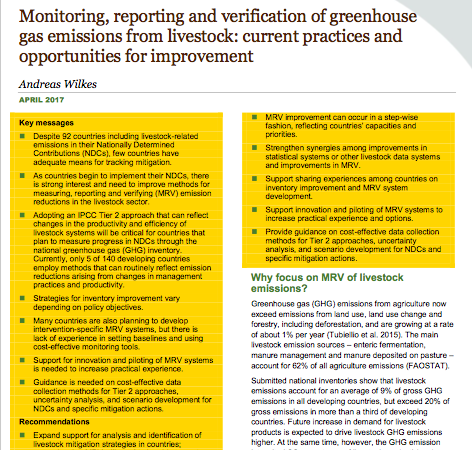
Greenhouse gas (GHG) emissions from agriculture now exceed emissions from land use, land use change and forestry, including deforestation, and are growing at a rate of about 1% per year (Tubiellio et al. 2015). The main livestock emission sources – enteric fermentation, manure management and manure deposited on pasture – account for 62% of all agriculture emissions (FAOSTAT). Submitted national inventories show that livestock emissions account for an average of 9% of gross GHG emissions in all developing countries, but exceed 20% of gross emissions in more than a third of developing countries. Future increase in demand for livestock products is expected to drive livestock GHG emissions higher. At the same time, however, the GHG emission intensity (tCO2e per tonne of livestock product) has been falling with the enhanced productivity and efificency of livestock systems (Caro et al. 2014) and is expected to continue to fall. Productivity and efficiency gains are important ways to meet increasing demand for livestock products while limiting impact on the global climate system (Gerber et al. 2013, Havlík et al. 2014).
As part of their contribution to the Paris Agreement, 92 developing countries included livestock-related emissions in the scope of their INDCs, including 48 that explicitly mentioned intentions to reduce emissions from livestock- related sources (enteric fermentation, manure management and biogas, grasslands and silvopastoral systems). Seventeen countries have proposed livestock mitigation policies and measures such as Nationally Appropriate Mitigation Actions (NAMAs). Associated with these plans is growing interest in improving measurement, reporting and verification (MRV) of livestock emissions (Box 1).
Guidance from the Intergovernmental Panel on Climate Change (IPCC) for compilation and reporting of national GHG inventories provides methodological options for estimating livestock GHG emissions (IPCC 1996, IPCC 2006). Tier 1 methodologies use fixed values for GHG emissions per head of livestock, so this quantification approach can only reflect changes in livestock populations. Tier 2 methodologies – which require more detailed information on different categories of animal and data on livestock weight, weight gain, feed digestibility and other factors – are better able to capture the effects of changes in management on GHG emissions. However, only 5 of 140 developing countries have adopted a Tier 2 approach that can routinely capture changes in productivity and efficiency of livestock systems in reporting to the UNFCCC. Another 16 developing countries are currently using a Tier 2 approach to calculate country- and system-specific emission factors, but their reporting systems are unable to capture ongoing changes in productivity that affect emission factors and emission intensity over time.
Within this context, CCAFS, the Global Research Alliance on Agricultural Greenhouse Gases (GRA) and the Food and Agriculture Organization of the United Nations (FAO), with support from the New Zealand government, the United States Agency for International Development (USAID) and the World Bank, embarked on a study of current MRV practices and opportunities for improvement.
The study focused on three areas:
- Do current livestock GHG emission MRV practices meet countries’ policy needs?
- What are the common barriers to improving MRV of livestock GHG emissions?
- How can international organizations support improvements in MRV of livestock GHG emissions?
UNIQUE Forestry and Land Use GmbH conducted a desk study and interviews. At a CCAFS-GRA-FAO-World Bank workshop in Rome in February 2017, 32 experts from developing and developed countries deliberated on a draft discussion paper, providing further insights on countries‘ priority concerns, constraints and plans. This info note summarizes key findings from the process; full results will be published in a CCAFS report by Wilkes et al. (2017).








